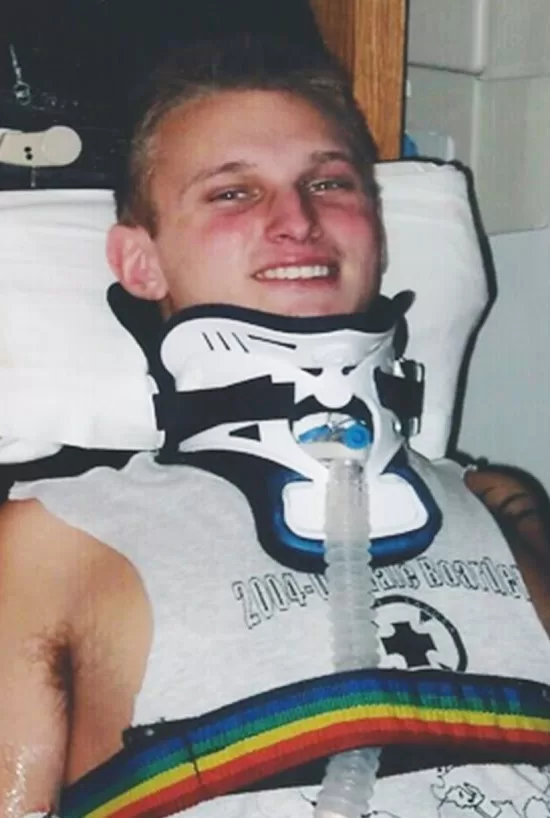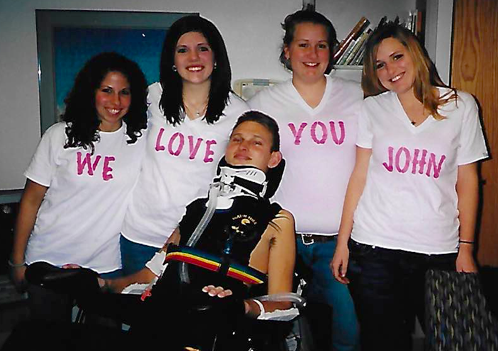This is the fourth installment of a series of reflections, anecdotes and interviews that tell the story of a young man learning to live with a major disability, and the friendship that has grown between him and TNT contributor, Jimmy P. Morgan. New installments are published monthly in TNT’s Storyland section. topanganewtimes.com/feature/storyland

As we started out for I-25 South to Denver on a chilly Wednesday morning, I asked JMo about his experiences in the hospital after he broke his neck. “You mean,” he asked, “other than becoming achingly familiar with the ICU’s ceiling?”
I was reminded of a lengthy dental procedure staring up at a poster; a bucolic outdoor scene to take my mind off of all the whirring, poking, and drilling. Of course, my angst was tempered by the knowledge that, in a few hours, I would have my verticality restored.
JMo doesn’t shy away from describing the harsh truth of his damaged body. “I’m a C4,” he often says. With cervical vertebrae #1 at the very top of the spine, a designation of C4 means that bodily functions associated with everything below cervical vertebrae #4 have been impaired. In JMo’s case, this includes the loss of bladder and bowel control, impairment of the diaphragm making breathing difficult and, of course, the complete loss of limb function.
When JMo did his head-first dive into that Kansas hillside, the brutal impact found its pivot point at C5 which is where his spinal cord was ruptured, just below C4. As John and his life-partner, Arianna, have been taught to understand what has happened, “imagine a length of ropy mozzarella string cheese sitting outside on the sidewalk during a hot day. Now, push your finger into the cheese to create an indentation. This is what JMo’s C5 vertebrae did to his spinal cord. Since the spinal cord wasn’t completely severed, this type of injury is considered “incomplete.” The result is that JMo has “some neural connectivity” to the impaired part of his body which has him sensing when a foot is out of place; or when he is not situated correctly in his wheelchair.

The first order of business in putting JMo back together again was to stabilize his neck. Using eight screws, doctors installed two 4-inch titanium rods which hold in place two metal cages that now traverse his spinal column from C3 down to C7. The C5 vertebrae was reconstructed using the patella (kneecap) of a cadaver so, as JMo laughs, “thanks buddy, whoever you were.”
JMo also needed a tracheotomy; a horizontal incision made in the front of his neck and through the rib of the trachea where a breathing tube was inserted. “It took me four months,” JMo says casually, “to learn how to breathe on my own again. And swallowing felt like something was caught in my throat… an awful feeling I never got used to.”
After that, surgeons inserted two IVC (Inferior Vena Cava) filters which run through the femoral artery of each leg. The filters, JMo adds, “prevent blood clots, the ‘silent killer,’ from making their way into my lungs or heart. I’ve lost a few friends who have died due to the lack of an IVC filter. I consider myself very lucky.” And, within a sentiment that has repeated itself throughout JMo’s life, he adds, “I always seem to be around the right people with the right knowledge, at the right time.”
Part of that “luck” is JMo’s access to Craig Hospital near Denver; a 93-bed specialty hospital treating those with spinal cord and brain injuries, SCI and BI. This is where JMo was first treated. He has returned many times over the years, often for continued care but also, more recently, as a Peer Mentor to those going through the early days of dealing with a life transformed by SCI or BI. JMo attributes much of his emotional and physical success to the personnel at Craig Hospital.

After a long month of surgeries, JMo joined the general population at Craig “where I started my four months of intense rehabilitation. I received physical therapy, attended educational classes about SCI, and participated in several other rehab assignments based on my specific injury. Learning about my ‘new self’ was a full-time job. I eventually embraced the reality of my situation due to the hard work, commitment and positivity of an army of doctors, nurses, therapists… everyone.” The Craig Hospital Philosophy is a straightforward statement of hope: “Although your life has significantly changed, you still can go back into the world and have a good life, and we will show you how.”
Leaving this intensely supportive environment of trained professionals, it was now time to take on a new challenge. “Once a few months had passed,” JMo told me as we rolled down Colfax Avenue to Chanda*, “and my body and mental state were getting used to this new lifestyle, it was time for me to brace myself for the cold hard reality of going home.”
*The Chanda Center for Health in Lakewood, Colorado (a suburb of Denver) offers comprehensive therapies “and other complementary services to reduce health disparities and costs… for individuals with physical disabilities through the support of the Chanda Plan Foundation…” To learn more or offer support, visit https://chandacenter.org/.





